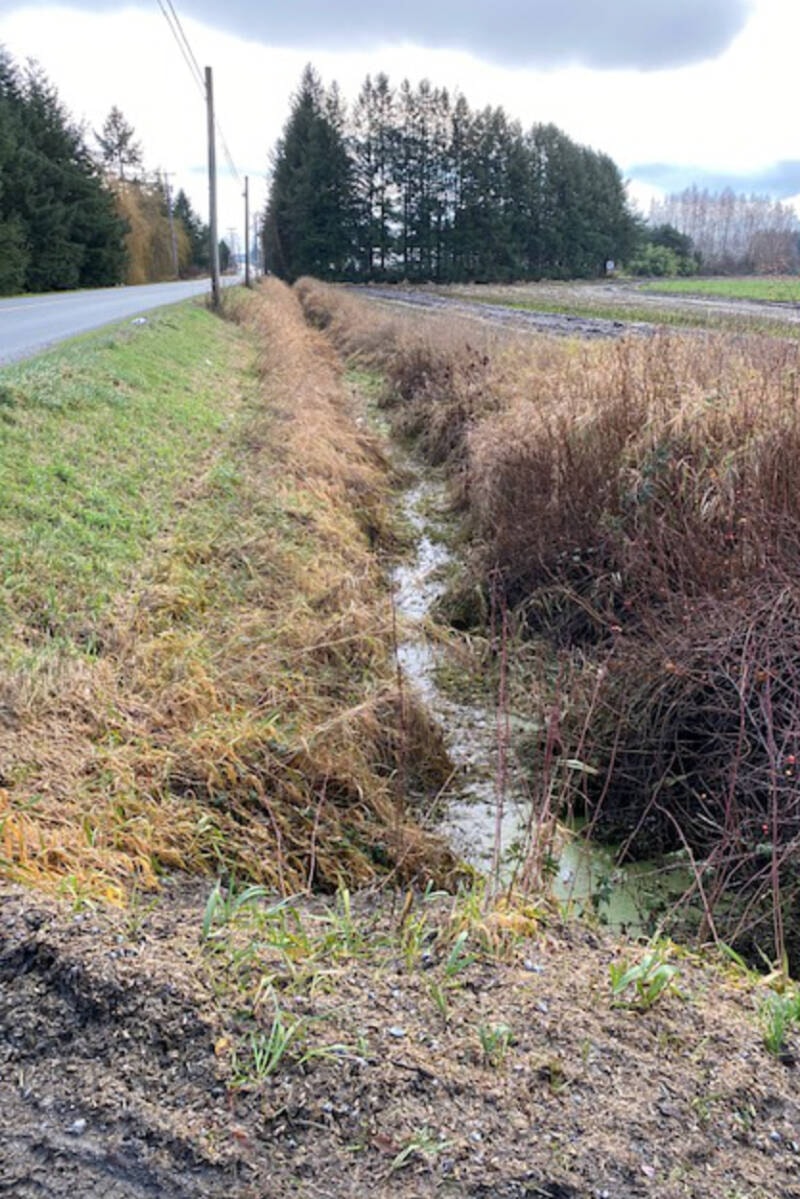A Pitt Meadows resident is concerned weeds are clogging up the Katzie Slough and surrounding ditches which could lead to future flooding in the area.
Bill Wild claims the weeds are so thick along some places in the slough that the waterway is only two or three feet wide in some places and even narrower in others.
Wild would like to see city staff pull weeds from the slough and ditches more frequently to allow for a higher volume of water to be passed through the waterways more efficiently if atmospheric rivers, like that the province experienced at the end of November, become more commonplace.
During the November rains, half of Wild’s property was under a foot of water, he said. He lives about 300 metres from a pump station right across from a dike.
“You couldn’t see my lawn, you couldn’t see my garden,” said Wild. “And I had a bit of water seep into the small basement that I have.”
All key ditches within Pitt Meadows are cleaned every four years, said Carolyn Baldridge with the City of Pitt Meadows. Occasionally, if there is an abundance of invasive species, then the city will do extra cleanings to promote proper drainage, she added.
This past fall, the city cleaned approximately 10 kilometres of the Katzie Slough, including sections of the waterway between Harris Road and Kennedy Pump Station, Baynes Road starting north of Ford Road, and under Golden Ears Way between Hammond and Lougheed Highway.
The City of Pitt Meadows has 11 flood gates, six pump stations, and 15 water pumps at dike stations that are there to protect city infrastructure from flooding.
However, Baldridge noted, weeds in the slough and adjacent ditches could not have prevented recent flooding in Pitt Meadows from the atmospheric river rain event at the end of November.
“The ability to drain the quantity of precipitation we saw from a drainage basin is very complex,” said Baldridge.
“When the November rain events happened, the surrounding soils were already saturated contributing to a decrease in natural water storage, resulting in surface flooding, which is to be expected in extreme storm events. Any water drained from the ditch was replaced by surface runoff until the water levels subsided,” she explained, adding that soil conditions and saturation impact flooding more than weeds in the ditches.
However, Wild said the problem is the slough has a “carpet of weeds” where ducks can literally walk on top of.
“That’s how thick they are,” he said.
Wild said the weeds displace the water in the waterways, giving it nowhere to go but to spill out onto local roads and properties.
“All those weeds are taking up space where water could be,” space that could give the city more time to deal with a deluge of rain, if another system were to hit the area, he said.
Wild thinks the city should be checking the slough and surrounding ditches every day. He believes water volume in the ditches could be increased by about 50 per cent just by getting rid of the weeds.
READ MORE: Torrential rains cause road closures in Pitt Meadows
ALSO: Climate change to put Pitt Meadows, Richmond and Ladner at risk of major river flood
When an atmospheric river is predicted, he added, it is not known exactly how much water can be expected.
But by increasing the amount of water that can be held in the ditches and the slough, the system could possibly hold one extra full days worth of rainfall when one of those heavy rains come through, said Wild.
“So what it does, it allows you one more day of grace before the real bad flooding starts to happen because you have retention of water in the ditches, much greater than what we have now.”
Baldridge noted the City of Pitt Meadows is looking at all aspects of the drainage system when considering how to best account for climate change.
Work, she said, is ongoing for the Baynes and Fenton Pump Stations, which includes the transitioning of existing pumps at Baynes Road Pump Station to the Fenton Station and the installation of new, higher capacity pumps at the Baynes Road Pump Station that is expected to improve overall efficiencies.
Back-up generators are also going to be installed – a project expected to be completed by mid-2022 – to ensure the pump stations keep working in the event of a power outage.
The last pump replacement to coordinate is at the Kennedy Road Station, which is currently planned for design in 2022 and construction in 2023, said Baldridge.
Have a story tip? Email: cflanagan@mapleridgenews.com
Like us on Facebook and follow us on Twitter.
